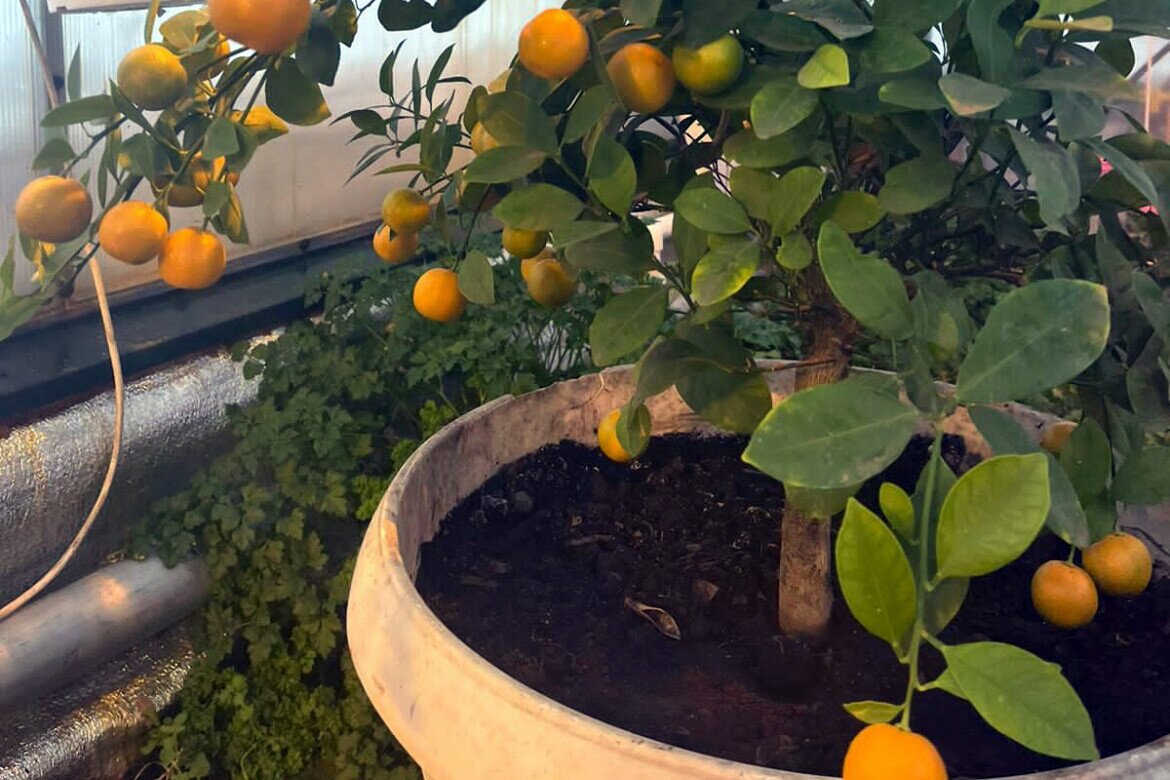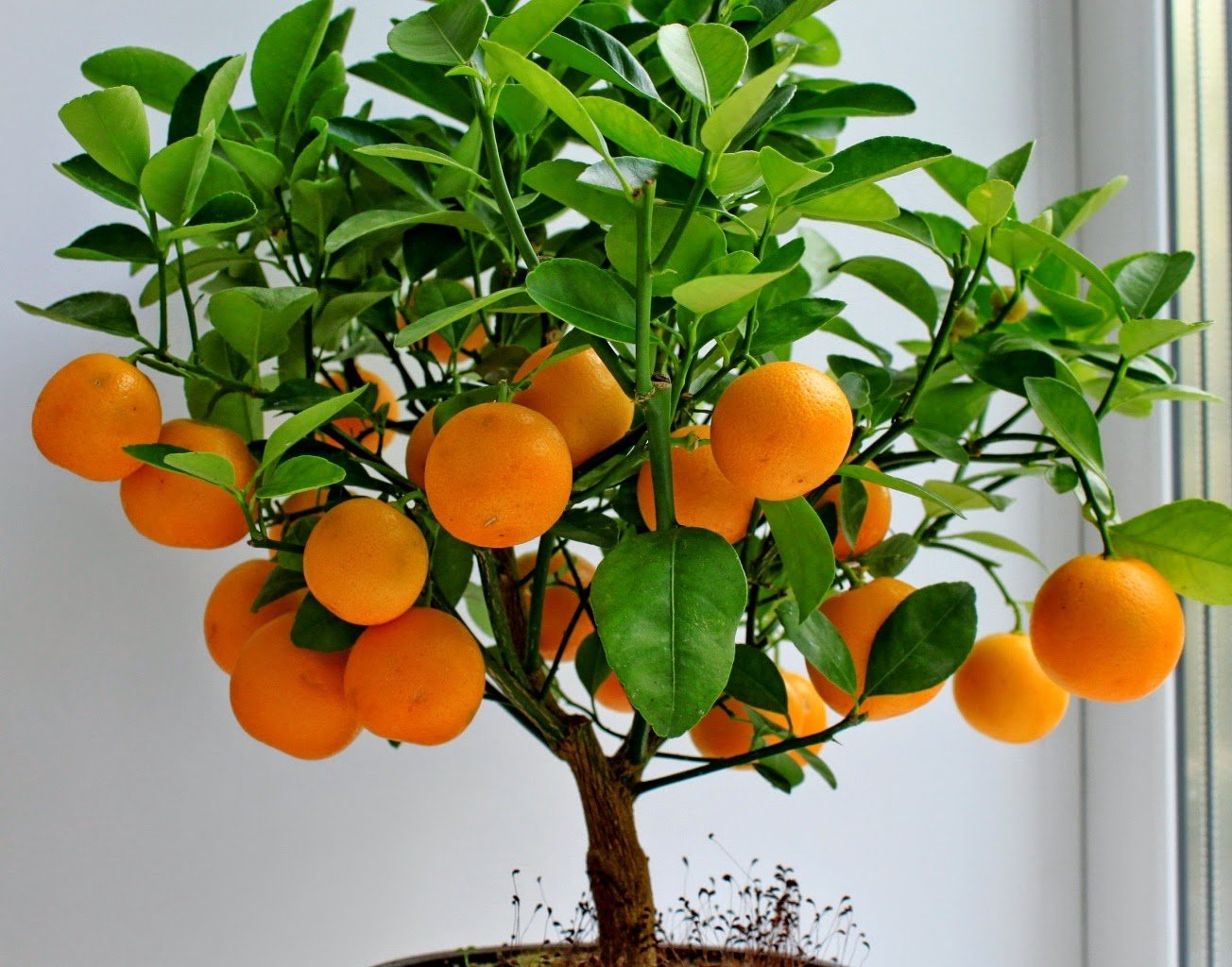How to grow oranges in a greenhouse? When to plant and how to care for them?

Growing oranges in Ukraine's climate is no longer an exotic dream, but a completely achievable reality thanks to modern greenhouse technologies. Imagine: snow lies outside, and you enter your greenhouse, where the air is filled with the intoxicating aroma of blooming citrus fruits, and bright orange fruits ripen on the branches. This isn't magic, but the result of a competent approach, precise calculations, and a passion for your craft.
The Foundation of Success: Choosing the Right Greenhouse and Variety
A mistake at this stage could cost you your harvest. A citrus greenhouse is more than just a shelter from the rain, but a complex, manageable ecosystem that you create and control. Let's look at each component in detail.
The Perfect Greenhouse for Golden Apples: An Engineering Approach
For a subtropical crop such as an orange, a capital, all-season thermos greenhouse is needed.
Construction and Frame
The choice of greenhouse shape affects light distribution and usable volume.
- Gable greenhouse ("house"): The classic and most preferred option for citrus trees. Straight walls provide maximum usable volume across the entire area, which is critical for tall trees. A slope angle of 25-30° promotes snow shedding and improves winter lighting.
- Arched greenhouse: A more economical option, it withstands wind and snow loads well. However, the usable space near the side walls is limited, which must be taken into account when planning plantings.
- Wall greenhouse (vegetarium): An ideal option for saving on heating costs. The north wall of the greenhouse is a load-bearing wall of the house, accumulating heat and protecting against winds.
Frame material:
- Profile galvanized pipe (40x20 mm and more): The gold standard. Ensures strength, durability, and corrosion resistance. The frame must be designed to withstand the snow load in your region (for Ukraine, from 80 to 180 kg/m²).
- Glued laminated timber (section from 100x100 mm): An aesthetic and environmentally friendly option, but requires mandatory treatment with antiseptics and fire retardants every 3-5 years.
Height: At least 2.5 meters at the lowest point near the wall and 3-3.5 meters at the ridge. This will ensure sufficient air volume and space for tree growth.
Coating: Cold Armor
- Cellular polycarbonate (Premium): A clear choice. The thickness is at least 10 mm, and for the northern regions of Ukraine - 16 mmKey parameters:
- Density: Not less than 0.8 kg/m². This guarantees strength and thermal insulation properties.
- UV stabilizing layer: A must! Applied to the outside of the leaf, it protects the material from sun damage and plants from harsh UV rays. Look for a manufacturer's warranty of at least 10 years.
- Heat transfer: The heat transfer coefficient of 16 mm polycarbonate is about 1.8 W/m² K, while that of 4 mm single glass is 5.8 W/m² K. The difference in heat saving is more than 3 times.
- Double-glazed windows: Maximum thermal insulation and light transmission. This is the most expensive, but also the most durable option, transforming the greenhouse into a true winter garden.
Life support systems
- Heating:
- Water: A solid fuel or gas boiler with two heating circuits: an upper circuit (radiators or pipes around the perimeter at a height of 1 m) for heating the air and a lower circuit (pipes buried 40-50 cm in the ground) for heating the root zone. This creates an ideal microclimate.
- Electrical: A combination of infrared heaters (providing targeted heat without drying out the air) and a ground heating cable. This requires precise power calculations and a reliable power supply.
- Minimum temperature: The system must be guaranteed to maintain a temperature of at least +5°C on the coldest nights.
- Lighting:
- Full Spectrum LED Grow Lamps: The most efficient and cost-effective option. They mimic sunlight, providing plants with all the necessary wavelengths.
- Power calculation: The average power requirement is 150-200 watts per 1 m² of tree crown area. For example, a tree with a crown projection of 1.5 m² would require a light fixture with a power of approximately 250 watts.
- Duration of supplementary lighting: From November to February, daylight hours are artificially extended to 10-12 hours. Use a time relay for automation.
- Ventilation and air circulation:
- Natural: Roof and wall vents (ideally at different levels to create draft). Installation of automatic, thermally operated vents is mandatory.
- Forced: For greenhouses larger than 20 m², it is recommended to install exhaust fans to ensure guaranteed air exchange and prevent stagnant moist air, which can cause fungal diseases.
The “Right” Orange: A Deep Analysis of Varieties and Rootstocks

Buying a seedling is an investment. It's important to know not only the variety (scion) but also what it's grafted onto (rootstock).
Rootstock Selection: The Hidden Foundation of Health
The rootstock is the root system on which the frost resistance of the roots, the growth strength of the tree and resistance to diseases depend.
- Poncirus trifoliata (Trifoliata): The most popular rootstock for growing in cool climates.
- Pros: It gives the tree relative frost resistance (the roots can withstand short-term freezing of the soil down to -10°C), inhibits growth (dwarfing effect), increases the sugar content of the fruit, and is resistant to root rot.
- Cons: Does not tolerate alkaline soils (requires slightly acidic soil).
- Citromelo: A hybrid of poncirus and grapefruit. A more vigorous and virus-resistant rootstock, but less frost-hardy.
Always check with the seller what rootstock the seedling is grafted onto!
Recommended varieties (Scions): from classics to exotics
- Classic and reliable:
- 'Washington Navel': The standard for dessert oranges. The fruits are large (200-300 g), juicy, and seedless. The tree is medium-sized. It requires stable conditions and is unforgiving of cultivation errors.
- 'Hamlin': "Workhorse." Early, very productive. Medium-sized fruits (150-180 g), ideal for juice. The tree is compact and more tolerant of temperature fluctuations.
- 'Valencia': A late-ripening variety, the "king of juice." The fruits can hang on the tree until summer without losing their quality. This allows for a longer consumption season.
- Gourmet and decorative: 4. 'Cara Cara Navel' (Cara Cara Navel): A navel orange with ruby-pink flesh. The flavor is very sweet, with notes of cherry and rose. A true delicacy. 5. 'Moro': One of the most vibrant "blood" oranges. The flesh is dark burgundy. For intense color, it requires a temperature difference between day and night during the ripening period (day +20°C, night +10°C). 6. 'Tarocco': Another "bloody" Italian. Considered one of the most delicious oranges in the world. The flesh is red-veined, very juicy and sweet.
- Compact varieties for small greenhouses and containers: 7. 'Skernevitsky': A Polish variety adapted to low-light and cool conditions. The tree is compact and produces fruit well in limited soil. 8. Pavlovsky: Although it's a lemon, it's often used as a standard for indoor citrus growing. Look for oranges grafted onto rootstocks of similar vigor and labeled as "dwarf" or "container grade."
Planting: the first step to harvest

Proper planting ensures the tree's health for years to come. This process can be compared to laying the foundation of a house: any mistake will manifest itself in the future.
When to plant? Calendar and microclimate
The optimal time for planting a seedling in a greenhouse is end of February – beginning of AprilHowever, this is not a strict dogma, but a recommendation. The main criteria are microclimate stability:
- Soil temperature: At a depth of 20-30 cm, the temperature should remain stable at +12…+15°C. Use a soil thermometer for monitoring.
- No night frosts: Even in a heated greenhouse, sudden temperature changes can cause stress in a young plant.
- Increasing daylight hours: The spring sun stimulates active sap flow and growth, helping the seedling adapt more quickly.
Autumn planting (September-October) This is also possible, but only if your greenhouse is fully equipped with heating and supplemental lighting. The plant will need at least 4-6 weeks to establish roots before entering dormancy.
Preparing a “house” for an orange: substrate and location selection
Soil Mix: Professional Recipe
Oranges require loose, well-drained soil with a slightly acidic pH (5.5–6.5). Using regular garden soil is a common mistake among beginners.
Substrate recipe “Expert” (in parts):
- Base (4 parts): 2 parts turf soil + 2 parts leaf humus (well rotted).
- Baking powder (2 parts): 1 part coarse-grained river sand (1-3 mm fraction) + 1 part agroperlite or vermiculite. Perlite improves aeration, vermiculite retains moisture.
- Acidifier and nutrition (2 parts): 1 part high-moor (red) peat + 1 part vermicompost or compost.
- Additives (per 10 liters of mixture): 1 glass of wood ash (source of potassium and microelements) and 1 tablespoon of superphosphate (for root development).
Before use, it is advisable to steam the mixture or pour it with a solution of “Fitosporin” for disinfection.
Container or open ground?
- Container (tub): Ideal for beginners.
- Volume: Start with a 20-30 liter container for a 2-3-year-old seedling. Every 2-3 years, repot it into a 15-20% container larger. The maximum capacity for a mature tree is 100-150 liters.
- Material: Wood (with an internal protective layer), ceramic (unglazed inside), high-quality plastic. Large drainage holes are a must!
- Greenhouse soil: Suitable for experienced gardeners.
- Preparation: A planting hole of at least 80 x 80 x 80 cm is dug. A 15-20 cm layer of drainage material (expanded clay or broken brick) is placed at the bottom. The hole is filled with the prepared substrate.
Step-by-step planting instructions: Technology for success
- Preparing the seedling: 2-4 hours before planting, immerse the root ball of the seedling in a bucket of water to which a root formation stimulator (Radifarm, Kornevin) and an anti-stress drug (Epin, Zircon) have been added.
- Drainage: Place a 10-15 cm thick drainage layer at the bottom of the hole or container. You can place a layer of geotextile on top to prevent soil from washing away.
- Formation of the mound: Pour a mound of prepared substrate into the center of the hole.
- Planting a seedling: Carefully remove the seedling from its transport pot. Inspect the roots: if they are tightly tangled, gently straighten them out. Place the seedling on the mound, distributing the roots evenly along its slopes.
- Root collar control: This the most important moment! The grafting site should be 5-7 cm above soil level, and the root collar (the point where the trunk meets the roots) should be 1-2 cm above that. It's better to plant slightly higher than too deep.
- Backfilling with soil: Gradually fill the hole with the substrate, carefully compacting it with your hands so that there are no air pockets.
- Watering and “shrinkage”: Water the seedling generously (20-30 liters of warm, settled water) until the water begins to flow out of the container's drainage holes or is completely absorbed into the hole. After the soil has settled, add more potting soil if necessary.
- Mulching: Mulch the tree trunk circle (40-50 cm in diameter) with pine bark, agrofibre, or peat. The mulch should not touch the trunk!
The Art of Grooming: Creating a Miniature Subtropical Garden

This is the most important stage, requiring a systematic approach.
- Temperature conditions:
- Growing season (spring-summer): +22…+28°C during the day, +16…+20°C at night.
- Dormant period (November-February): +10…+14°C. A cool winter is the key to future flowering and fruiting.
- Air humidity: 60–75%. In winter, when heating units are on, the air can become too dry. Use humidifiers or place containers of water. Regularly mist the crown with warm water.
- Watering: "It's better to underwater than overwater." Allow the top 3-5 cm of soil to dry out. Water generously but infrequently. The water should be settled, soft, and 2-3 degrees warmer than the air temperature. In winter, reduce watering to a minimum.
- Top dressing:
- From March to September: Once every 10-14 days. Alternate between complex mineral fertilizers for citrus (look for NPK 20-10-20, such as Master-Agro or Plantafol) and organic fertilizers (a 1:10 solution of mullein or a 1:20 solution of chicken manure).
- From October to February: Stop feeding or apply fertilizers with a minimum nitrogen content once a month if the plant continues to grow.
- Crown formation (pruning):
- Formative: This is done during the first 2-3 years. Young plants are tipped at a height of 20-25 cm to stimulate the growth of lateral shoots. Three or four of the strongest first-order shoots are left and pruned. Secondary shoots are then formed from these shoots, and so on, up to the fourth or fifth order, which is where fruit sets in.
- Sanitary: This is carried out annually in the spring. All dry, weak, diseased, and inward-growing branches are removed.
Garden protection: pests, diseases and control methods
The greenhouse creates ideal conditions not only for plants, but also for pests.
- Spider mite: Small spots on the leaves, a thin web. Leaves turn yellow and fall off. Control measures: Increase humidity, treatment with acaricides (Actellic, Vertimek).
- Scale insect: Brown plaques on the trunk and leaves. Control measures: Mechanical removal (with a brush soaked in alcohol) and treatment with systemic insecticides (Aktara, Confidor Maxi) are recommended. Treatments are repeated 2-3 times at 10-14 day intervals.
- Mealybug: White cotton-like coating in the leaf axils. Control measures: Similar to the fight against scale insects.
- Fungal diseases (gummy leaf spot, late blight): Often arise due to over-watering and deepening of the root collar. Prevention: Proper watering, good ventilation. Treatment: Cleaning the affected areas down to healthy tissue, treating with 3% copper sulfate solution and covering with garden pitch.
From Flower to Fruit: The Finishing Touches
- Pollination: Most modern orange varieties are self-pollinating. However, to ensure this, you can carefully transfer pollen from flower to flower with a soft brush during flowering.
- Crop rationing: During the first few years of fruiting, leave 2-3 fruits on the tree to avoid exhausting the young plant. As the tree matures, the load can be increased.
- Harvesting: Oranges don't ripen after picking. They should be picked when fully colored and ripe. Ripening time depends on the variety and can range from 7 to 12 months from flowering.
Growing Oranges in a Greenhouse: Conclusion

Growing oranges in a greenhouse is a fascinating process that will reward you not only with delicious and aromatic fruits, but also with the incomparable pleasure of creating a small subtropical paradise with your own hands. Yes, it requires investment, knowledge, and patience. But the sight of a blooming orange tree in the middle of winter and the taste of your own organic orange are worth all the effort.
The key pillars of your success are:
- Reliable all-season greenhouse: A sturdy frame, a warm polycarbonate covering, and sophisticated heating, lighting, and ventilation systems—this is your foundation.
- The right choice of seedling: An adapted variety on a stable rootstock from a proven nursery.
- Proper agricultural technology: Balanced watering, timely fertilizing, proper crown shaping, and vigilant pest control.
Creating your own citrus paradise is a fascinating journey that will reward you not only with organic, aromatic fruits but also with incomparable pleasure. The sight of a blooming orange tree in the middle of winter is worth all the effort.
Don't put off your dream! The first and most important step is creating the right "home" for your future pets. NovaTeplitsa offers a wide selection of permanent thermos greenhouses, ideal for growing citrus and other exotic crops. Our specialists will help you choose the optimal design and configuration tailored specifically to your needs and climate conditions.
Take a step towards your harvest – contact NovaTeplitsa today and make your orange orchard a reality!





